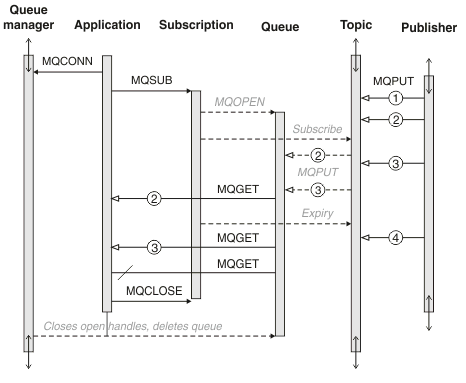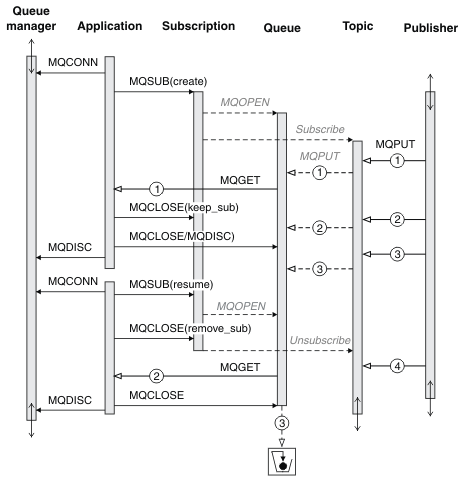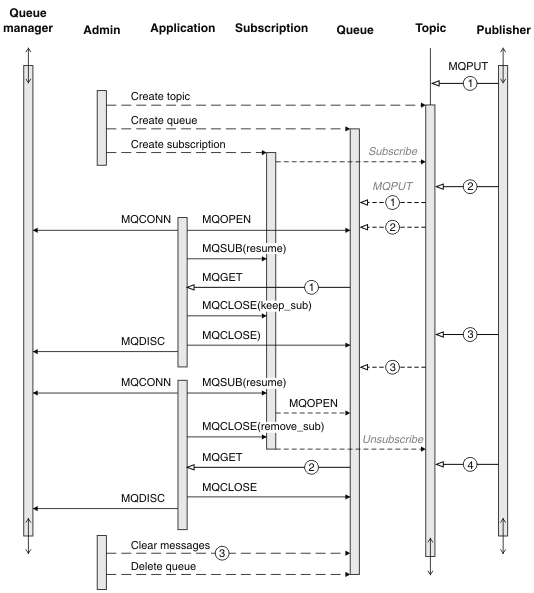Publish/subscribe lifecycles
Consider the lifecycles of topics, subscriptions, subscribers, publications, publishers and queues in designing publish/subscribe applications.
The lifecycle of an object, such as a subscription, starts with its creation and ends with its deletion. It may also include other states and changes that it goes through, such as temporary suspension, having parent and children topics, expiration and deletion.
Traditionally IBM MQ objects such as queues are created administratively, or by administrative programs using Programmable Command Format (PCF). Publish/subscribe is different in providing the MQSUB and MQCLOSE API verbs to create and delete subscriptions, having the concept of managed subscriptions that not only create and delete queues, but also clean up unconsumed messages, and having associations between administratively created topic objects and programmatically or administratively created topic strings.
This functional richness caters for a wide range of publish/subscribe requirements, and also simplifies designing some common patterns of publish/subscribe application. Managed subscriptions, for example, simplify both the programming and administration of a subscription that is intended to last only as long as the program that created it. Unmanaged subscriptions simplify programming where there is a looser connection between subscribing and consuming publications. Centrally created subscriptions are useful where the pattern is one of routing publication traffic to consumers based on a centralized model of control, for example sending flight information to automated gates, whereas programmatically created subscriptions might be used if gate staff are responsible for subscribing to the passengers records for that flight, by entering a flight number at a gate.
In this last example a managed durable subscription might be appropriate: managed, because the subscriptions are being created very often, and have a clear endpoint when the gate closes and the subscription can be programmatically removed; durable, to avoid losing a passenger record due to the gate subscriber program going down for one reason or another 1 . To initiate the publication of passenger records to the gate, a possible design would be for the gate application to both subscribe to the passenger records using the gate number, and publish the gate opening event using the gate number. The publisher responds to the gate opening event by publishing the passenger records - which might then also go to other interested parties, such as billing, to record the flight is taking place, and to customer services, to text notifications to passengers' mobile phones of the gate number.
The centrally managed subscription might use a durable unmanaged model, routing passenger lists to the gate using a predefined queue for each gate.
The following three examples of publish/subscribe lifecycles illustrate how managed non-durable, managed durable, and unmanaged durable subscribers interact with subscriptions, topics, queues, publishers and the queue manager, and how the responsibilities might be divided between administration and the subscriber programs.
Managed non-durable subscriber
Figure 1 shows an application creating a managed non-durable subscription, getting two messages that are published to the topic identified in the subscription, and terminating. The interactions labeled in an italic gray font with dotted arrows are implicit.
There are some points to note.- The application creates a subscription on a topic that has already been published to twice. When the subscriber receives its first publication, it receives the second publication which is the currently retained publication.
- The queue manager creates a temporary subscription queue as well as creating a subscription for the topic.
- The subscription has an expiry. When the subscription expires no more publications on the topic are sent to this subscription, but the subscriber continues to get messages published before the subscription expired. Publication expiry is not affected by subscription expiry.
- The fourth publication is not placed on the subscription queue and consequently the last MQGET does not return a publication.
- Although the subscriber closes its subscription, it does not close its connection to the queue or the queue manager.
- The queue manager cleans up shortly after the application terminates. Because the subscription is managed and non-durable, the subscription queue is deleted.

Managed durable subscriber
The managed durable subscriber takes the previous example a step further, and shows a managed subscription surviving the termination and restart of the subscribing application.
There are some new points to note.- In this example, unlike the last, the publication topic did not exist before it was defined in the subscription.
- The first time the subscriber terminates, it closes the subscription with the option MQCO_KEEP_SUB. That is the default behavior for implicitly closing a managed durable subscription.
- When the subscriber resumes the subscription, the subscription queue is reopened.
- The new publication 2, placed on the queue before it is reopened, is available to MQGET, even after the subscription has been removed.
Even though the subscription is durable, the subscriber reliably receives all messages sent by the publisher only if both the subscription is durable and the messages persistent. Message persistence depends on the setting of the Persistent field in the MQMD of the message sent by the publisher. A subscriber has no control over this.
- Closing the subscription with the flag MQCO_REMOVE_SUB removes the subscription, stopping any further publications being placed on the subscription queue. When the subscription queue is closed, then the queue manager removes the unread publication 3, and then deletes the queue. The action is equivalent to administratively deleting the subscription. Note: Do not delete the queue manually, or issue MQCLOSE with the option MQCO_DELETE, or MQCO_PURGE_DELETE. The visible implementation details of a managed subscription is not part of the supported IBM MQ interface. The queue manager manage cannot manage a subscription reliably unless it has complete control.

Unmanaged durable subscriber
An administrator is added in the third example: the unmanaged durable subscriber. It is a good example to show how the administrator might interact with a publish/subscribe application.
The points to note are listed.- The publisher puts a message, 1, to a topic that later becomes associated with the topic object that is used for subscription. The topic object defines a topic string that matches the topic that was published to by using wildcards.
- The topic has a retained publication.
- The administrator creates a topic object, a queue and a subscription. The topic object and queue need to be defined before the subscription.
- The application opens the queue associated with the subscription and passes MQSUB the handle of the queue. It could, alternatively, simply open the subscription, passing it the queue handle MQHO_NONE. The converse is not true, it cannot resume a subscription by passing it only queue handle without a subscription name - a queue might have multiple subscriptions.
- The application opens the subscription using the option MQSO_RESUME even though it is the first time it has opened the subscription. It is resuming an administratively created subscription.
- The subscriber receives the retained publication, 1. Publication 2, although published before any publications were received by the subscriber, was published after the subscription started, and is the second publication on the subscription queue. Note: If the retained publication is not published as a persistent message, then it is lost after queue manager restart.
- In this example the subscription is durable. It is possible for a program to create an unmanaged non-durable subscription; it should be obvious this is not something an administrator can do.
- The effect of the option MQCO_REMOVE_SUB on closing the subscription is to remove the subscription just as if the administrator had deleted it. This stops any further publications being sent to the queue, but does not affect publications that are already on the queue, even when the queue is closed, unlike a managed durable subscription.
- The administrator later deletes the remaining message, 3, and deletes the queue.

A normal pattern for an unmanaged subscription is for queue and subscription housekeeping to be performed by the administrator. Typically one would not attempt to emulate the behavior of a managed subscriber and tidy up queues and subscriptions programmatically in application code. If we find yourself needing to write management logic, question whether we can achieve the same results using a managed pattern. It is not easy to write tightly synchronized, completely reliable management code. It is easier to tidy up later, either manually, or using a automated management program, when we can be sure that messages, subscriptions, and queues can be simply deleted, regardless of their state.
Parent topic: Writing publish/subscribe applications 1 The publisher must send the passenger records as persistent messages to avoid other possible failures, of course.